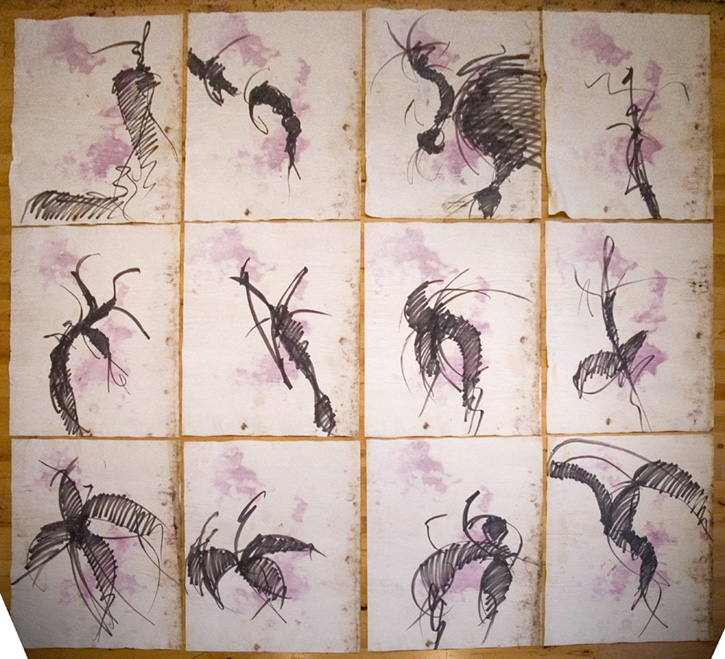The following was written originally as a response to “Unrelenting analysis” continues to grip art world on Two Coats of Paint. But alas, being over 4096 characters, my comment was too long to be posted, so I have revised and extended my remarks; and added a few links to clarify certain points. My point of entry was this comment on the site which dismissed the work as “Game playing posing as art.”
Game playing posing as art; indeed, that’s a fair critique, but one that I would suggest is a bit limiting. I would suggest that the game, as embodied in “Hirsh E.P. Rothko’s Hirsh E.P. Rothko” is in fact the art in this case, which renders critiques of the paintings, in a vacuum, as beside the point.
Regional Painting? No, Regional Writing; and the region in question is of course New York City, rather than Colorado. The written “Hirsh E.P. Rothko” thesis essay is the true center of the exhibition, while the paintings themselves function as an appendix, at least in my view. On looking at online reproductions, I feel mostly a sensation of indifference. I don’t doubt Ho’s sincerity in making them, but they seem to function as souvenirs of his dozen consecutive sojourns as a “30 day local” (to borrow a term from his thesis).
In the NY Observer video, Ho states he wanted to “get away from critical theory” or words to that effect. But rather than make a clean break and live thereafter as a regional painter, Ho has of course returned to what appears to be his natural habitat: the august halls of critical theory and conceptualism.
Looking at his web site, one finds no evidence that Ho has produced a body of paintings before. Instead, one finds a detailed listing of his curatorial and professorial endeavors, along with a lengthy list of “projects” that one suspects were driven by the “publish or perish” imperative of academia. Thus, while the paintings may be sincere, there’s no indication that Ho intends to continue as a full-time painter; hence the validity (although rough) of some of the critiques.
So let’s leave the paintings aside as a red herring; a Dadaist souvenir; something that distracts from the heart of the matter, which is of course, the tale of “Hirsh E.P. Rothko.” Rothko is presented as an unsympathetic character: a hack; a possible sexual molester of the student-teacher variety; and an incurable snob of critical theory and art history. Cast forth from the temple of RISD, “Rothko” finds redemption in the “Stomparillaz” lifestyle of carefree mountain biking, casual drug use, and attempts at “authentic unmediated” painting.
Consider now the matter of authorship. Ho hides behind layers of anonymity, claiming it’s all by this fictitious character, Hirsh E.P. Rothko, along with an imaginary scribe, Inez Kruckev. This is of course, quite funny and entertaining, far more than the typical academic thesis or Artforum essay; and for that, we must give credit to Ho for injecting some life into the often deadly multitude of pages that populate his world of critical theory and conceptualist art.
But ultimately, someone must take credit, so for further discussion, I must cast aside this “where’s Waldo” take on authorship, and simply consider it all as the work of the person on the copyright line: Ho himself. Likewise, one must disregard the standard “fiction writing” disclaimer inserted at the beginning, when it coincides rather too neatly with a real person (other than Ho) with a vested interest.
That person, of course, is dealer Edward Winkleman, who makes three appearances in the book. Winkleman is in fact the “plus ultra” of the whole endeavor, the reason for going further, beyond the confines of New York, and then returning with the souvenirs. The whole thing is a wonderful example of “curator’s art” – a coinage (of Roberta Smith’s) that Winkleman himself cites with approval in one of his blog posts. But contrary to Winkleman’s assertion that this term may be used dismissively, I think we should take this term as an honest reflection of what’s actually going on and celebrate it. To take it one step further, we might even call it “dealer’s art” since Winkleman himself is such a central character to the success of the endeavor.
The writing might also be called a fairy tale for artists; one in which the princess Ho is rescued by Prince Winkleman, to be spirited back to safety in his home region. Without this rescue device, “Rothko” would of course labor in obscurity, never achieving recognition for anything more than smearing feces on a bathroom wall, an act he takes unearned credit for in one of the opening scenes of his story.
While the book is presented with a certain amount of glib recitation of the tenets of art history along with moments of snarky pomposity, one must be forgiving, in my opinion, and note that such self-indulgence is part of the standard dialogue for practitioners of curator’s art; or dealer’s art, as the case may be. It’s all part of the game; the game in which the “book of Rothko” is the point of reference, rather than the paintings.


